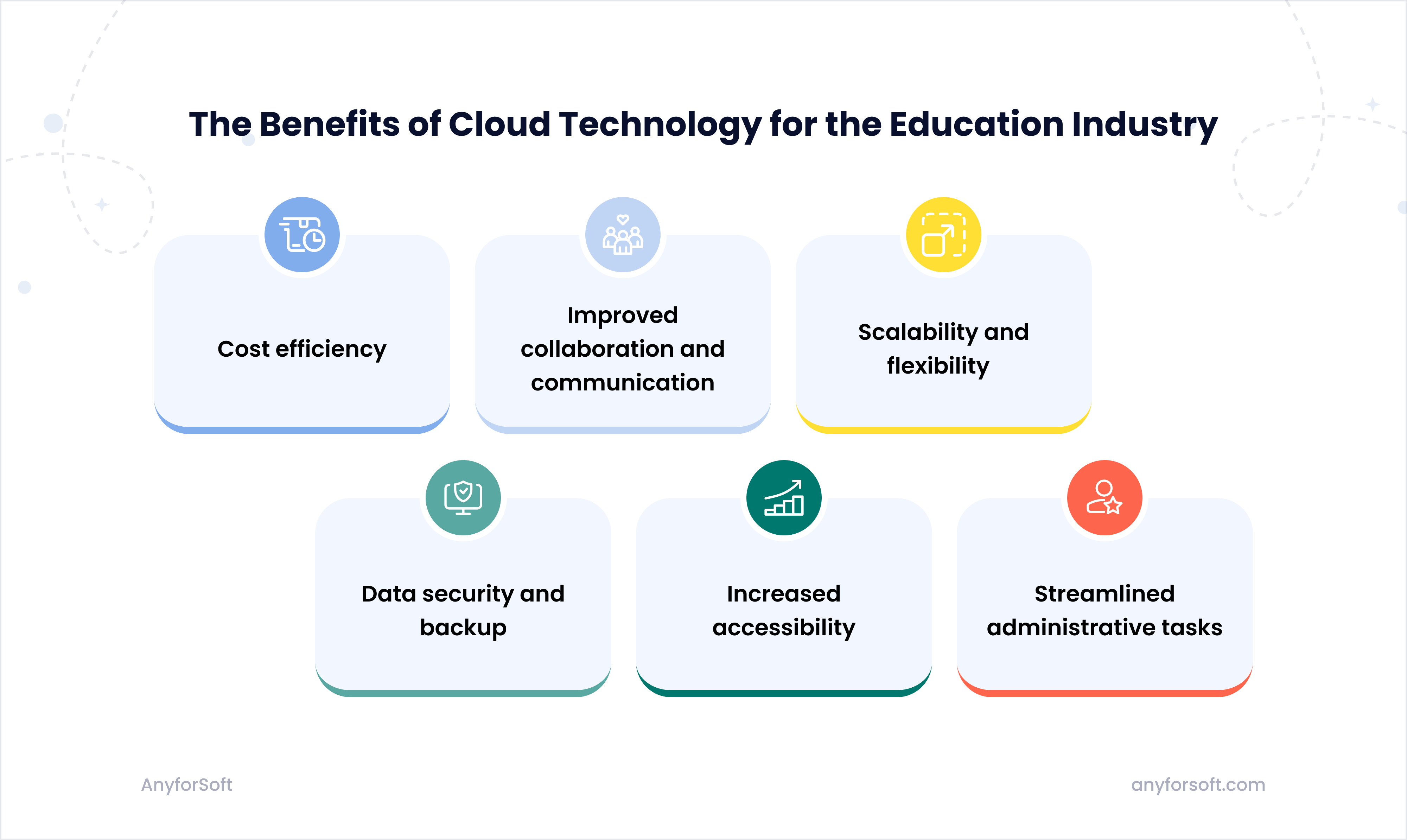We’ve seen a big change in how we teach students over the last few years and cloud edtech is leading the way in transforming classrooms and learning spaces. Cloud technology in education gives schools, universities, and even small educational institutions flexible and scalable solutions to enhance the learning experience and make education more accessible.
With cloud-based platforms, educators can deliver high-quality educational materials, enable real-time collaboration, and support diverse learning processes across geographical boundaries. But what exactly does this mean for the future of education? Let’s break it down by looking at how cloud services reshape how we teach and learn.
The Benefits of Cloud Technology for the Education Industry
Cloud computing in education brings numerous advantages to the sector. Here are some of the ways it’s helping schools and universities improve the learning experience:
- Cost efficiency
Cloud computing saves schools and universities money by reducing the need for expensive hardware, software, and IT staff. With cloud-based solutions, institutions can access tools like virtual classrooms, data storage, and content management platforms without large upfront costs. You can subscribe to cloud services on a pay-as-you-go model, scaling resources as needed. This means you can allocate your budget to other important areas like improving learning materials or supporting faculty development.
- Improved collaboration and communication
Cloud platforms allow students, teachers, parents, and staff to collaborate in real time from anywhere. Whether it’s through platforms like Google Classroom or Microsoft Teams powered by cloud services, students can access assignments, learning materials, and feedback without being limited to a traditional classroom setting. They provide access to tools such as online collaborative workspaces, discussion forums, and video conferencing. This level of flexibility fosters a more interactive and engaging learning environment.
- Scalability and flexibility
One of the key benefits of cloud-based systems is their ability to scale effortlessly. Schools no longer have to worry about costly infrastructure upgrades or server limitations. Instead, they can simply adjust their usage as needed, paying only for what they consume. Cloud services offer virtually unlimited storage capacity for educational content, student data, and administrative records. These scalability and flexibility enable educational institutions to easily adapt to growing student populations and changing technological demands, such as the need for online courses, remote learning, and hybrid learning environments.
- Data security and backup
The fact is, educational institutions get to deal with tons of sensitive data like that belonging to students’ records and research materials. Cloud has more security measures like encryption, access controls, regular data backup, and the recovery of all systems in any case (unforeseen disaster). With the right cloud migration consulting, institutions can also be protected against cyber threats and never get skinned in case of an emergency at work.
- Increased accessibility
This is probably the biggest influence cloud technology has in various fields including education. Cloud-based services have enabled everyone to reach and consume quality educational content. Learning has become more inclusive. Whether students are in urban centers or remote areas, they can access the same resources, participate in lessons, and collaborate with their peers. All you need is a suitable device and Internet access and you can study anytime, anywhere. This helps level the playing field for students who might otherwise struggle to access quality education.
- Streamlined administrative tasks
Cloud-based systems automate administrative tasks such as grading, attendance tracking, and student information management, freeing up educators’ time to focus on teaching and student interaction.

Impact of Cloud Computing on Online Education
If you work in the education industry, you’ve probably already come across the realization that you need to be able to adapt to the trends in EdTech, which are constantly evolving and changing. We can already see that online education is growing exponentially. What role does cloud computing play in this process? With more and more students participating in distance learning, the importance of cloud platforms in ensuring accessibility, flexibility, and efficiency of education cannot be overstated. Let’s take a closer look.
Supporting remote learning
The global shift to remote learning, especially during the COVID-19 pandemic, highlighted the importance of cloud computing technologies in sustaining education. Cloud-based platforms allowed educational institutions to continue delivering lessons, managing virtual classrooms, and maintaining the learning process without any major setbacks.
Cloud-based solutions enable everything from live streaming of lectures to digital assignment submissions, making education more adaptable to students’ varying needs. With that said, cloud-based solutions have made it possible for remote learning to become an established part of education technology and how education is done today.
Streamlining learning management systems (LMS)
Cloud computing has vastly improved learning management systems, now allowing seamless course delivery, assignment tracking, and student progress monitoring on a single platform. Popular LMS platforms like Moodle and Canvas, are cloud-based, allowing for real-time updates and making the learning process more intuitive and efficient for both teachers and students.
Facilitating personalized learning
In the same way, cloud platforms also help in a much easier approach to personalized learning by schools. And with the power of artificial intelligence (AI), data analytics means teachers can easily track student learning, find out which parts they are struggling with, what modes work best to teach them, and then deliver lessons tailored specifically for that learner.
Providing interactive learning content
Cloud computing also enabled the creation and delivery of more exciting, innovative online learning solutions. Various educational tools like virtual labs, simulations, and games for interactive learning can be easily available on cloud-based platforms. This opens up the possibilities for online learning to be interactive, improving its effectiveness.
Examples of Cloud-Based Software in EdTech
There are plenty of cloud-based tools that help educational organizations and students thrive in the modern classroom. Here are a few examples of cloud-based software that empowers educational organizations:
Google Classroom
Google Classroom simplifies the process of creating, distributing, tracking, and grading assignments digitally. Teachers can share educational materials, provide real-time feedback, and keep students engaged, all within a cloud-based platform. It facilitates real-time collaboration and helps educators manage communication with students effortlessly.

Amazon Web Services (AWS)
AWS provides scalable cloud solutions that many educational institutions rely on. It offers data storage, analytics, machine learning tools, and computing power to manage educational content, enabling institutions to serve thousands of students without needing to invest heavily in infrastructure. Many educational institutions use AWS to run their digital base, support research, and develop online courses.

Microsoft Teams
Microsoft Teams combines video conferencing, file sharing, and real-time collaboration in one platform, making it ideal for online classes, group projects, virtual meetings, remote learning, and parent-teacher conferences. Zoom and Google Meet play the same role.

Microsoft Azure for Education
Microsoft Azure provides the infrastructure for many edtech applications and services. This platform offers a range of cloud-based tools and resources that help educational institutions improve teaching, learning, and administrative processes. With Azure, schools and universities can host virtual labs, deliver online classes, and provide students with access to powerful learning tools.

Moodle
Moodle is an open-source cloud-based LMS that allows institutions to create custom e-learning environments. It supports various educational resources and is used by universities, colleges, and training centers worldwide to manage online courses and assessments.

Gradelink, PowerSchool, and Infinite Campus
These are so-called Student Information Systems (SIS). Cloud-based systems like Gradelink, PowerSchool, or Infinite Campus manage student data, attendance, grades, and other administrative information. These SIS platforms can also offer opportunities for automated grading and personalized feedback.

Adopt Cloud for Education with AnyforSoft
At AnyforSoft, we specialize in providing custom education software development services, including cloud-based solutions that meet the unique needs of educational organizations. Our team will help you implement robust and scalable cloud technologies that improve the teaching and learning process and boost operational effectiveness.
Would you like to implement a learning management system, create interactive online courses, or refine administrative processes? Or do probably you need to integrate real-time collaboration tools? We have the expertise to guide you through every step of the process. Our tailored solutions are designed to support your institution’s goals and make your transition to cloud computing smooth and successful. Feel free to reach out for details and assistance.
In summary
Cloud-based Edtech accelerates the pace of innovation in education, ultimately making it possible for institutions to provide a better learning experience at lower operational costs and higher efficiency. By leveraging cloud technology, educational institutions can expand access to educational resources, support personalized learning, and enable real-time collaboration.
The more education goes digital, the more the cloud will continue to empower educators and learners to make learning enjoyable, effective, and inclusive. If you are ready to embrace cloud implementation services and reimagine your educational offerings, contact AnyforSoft today to get started.








